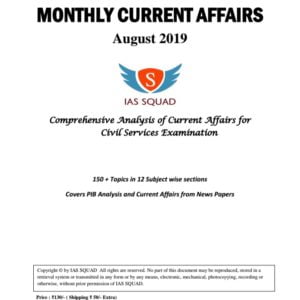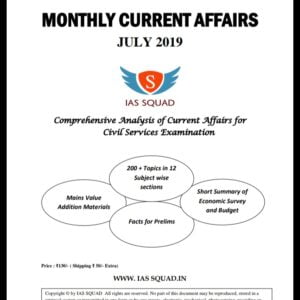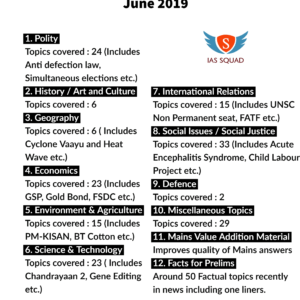Daily Current Affairs for UPSC CSE
Topics Covered
- Section 69(A) of the Information Technology Act, 2000
- Mo Sarkar
- Decision of England & Wales High court on Nizam’s Fund
- Village Secretariat Programme
- Monsoon Mission Coupled Forecast Model (CFS)
- Facts for Prelims : Exchange Traded Fund
1 . Section 69(A) of the Information Technology Act, 2000
Context : According to Twitter records, many content removal demands from the Ministry of Electronics and Information Technology simply cited a violation of Section 69(A) of the Information Technology Act, 2000.
About Section 69 (A)
- Section 69A of the IT Act, empowers the Central Government to order that access to certain websites and computer resources) be blocked in the interest of the defense of the country, its sovereignty and integrity, the security of the State, friendly relations with foreign States, public order or for preventing incitement to the commission of an offence.
- The details of the procedural safeguards that had to be followed while blocking access were set out in in more detail in the Information Technology (Procedure and Safeguards for Blocking for Access of Information by Public) Rules, 2009
- Blocking can be carried out only when the Central Government is satisfied that it is necessary and the restrictions sought to be imposed fall squarely within the reasonable restrictions to freedom of speech and expression under Article 19(2).
- It cannot be carried out without the approval of a committee that, at least, theoretically would take into account the views of all affected parties.
- The intermediary who fails to comply shall be punished with an imprisonment for a term which may extend to seven year and also be liable to fine.
2 . Mo Sarkar
Context : Odisha Chief Minister Naveen Patnaik to Wednesday launched his government’s new governance initiative ‘Mo Sarkar’ on the occasion of Gandhi Jayanti
About Mo Sarkar
- The objective of the ‘Mo Sarkar’ programme is to provide service with dignity to people who are coming to government offices for different purposes.
- The phone numbers of people who are coming to government offices will be collected randomly with the purpose to improve the governance system by collecting feedback on behaviour and professionalism of government officers.
- The Chief Minister, Departmental Minister, Director General of Police (in case of police stations) and Departmental Minister, Secretary and Director (in case of hospitals) will call on random numbers to collect feedback.
- The employees will be ranked as good or bad on the basis of the feedback and those with good rank will get out-of-turn promotion and action will be taken against employees with bad rank.
3 . Decision of England & Wales High court on Nizam’s Fund
Context : Rejecting Pakistan’s claim in the case that dates back to 1948, the High Court of England and Wales ruled in favour of India and the Nizam’s descendants — now mostly based in Turkey and the U.K. — granting them access to a £35 million fund (worth approximately ₹306 crore)
About the Dispute
- The case relates to the transfer of £1,007,940 (now worth £35 million) and nine shillings by the Nizam’s envoy and foreign minister in London, Moin Nawaz Jung, on September 16, 1948 to Pakistan when the Indian Army’s tanks were closing in on Hyderabad from all directions.
- Moin Nawaz Jung transferred the money to the account of Habib Ibrahim Rahimtoola, the High Commissioner of Pakistan in London, which the bank processed on September 20, 1948.
- However, Hyderabad’s armed forces had already surrendered to General J.N. Chowdhury on September 17, 1948 after a military operation known as “Operation Polo.”
- Within days of surrender, the Nizam, Osman Ali Khan, sent a message to the National Westminster Bank demanding that the money be transferred back to his account. Pakistan also claimed the money.
- The Fund had been held in the account of the High Commissioner of Pakistan to the UK Rahimtoola since September 1948.
- In 1965, the Nizam assigned to the President of India, his claim to the fund, and joined forces with India to fight for his claim on the money. He died in 1967.
- The Nizam’s descendants, Prince Mukarram Jah — the titular eighth Nizam of Hyderabad — and his younger brother Muffakam Jah, carried on the legal battle.
Arguments of Pakistan
- Pakistan’s claim rested on the premise that the money was transferred for the weapons supplied by the country to the Nizam
- The facts of this case were such as to render it non-justiciable because the original transfer was governmental in nature and that India’s annexation of Hyderabad in 1948 was an unlawful act, which tainted India and Nizam VIII’s claim.
Court Judgement
- As per the judgment “Nizam VII was beneficially entitled to the Fund and those claiming in right of Nizam VII — the Princes and India — are entitled to have the sum paid out to their order”.
- The Court rejected arguments advanced by Pakistan that the dispute was non-justiciable, either in whole or in part; that the doctrine of illegality somehow barred recovery; or that the claims of other parties were time barred. The Court held that Pakistan’s pleading of limitation was an ‘abuse of process’, and that remedies in trust law and restitution were available against both Pakistan and the Bank
4 . Village Secretariat Programme
About Village Secretariat Programme
- Under the new system, one Village Secretariat has been set up for every population of 2,000, with each one comprising close to a dozen village officials (from different departments like police, revenue, etc).
- The idea behind it, according to the state government, is to ensure that its services reach people on the ground, and also to strengthen the existing Panchayat Raj system.
- These institutions would act as a bridge between the government and the people by rendering over 500 types of services at their doorstep. They will also showcase government programmes and make pictorial representations of government schools and hospitals under the caption ‘then and now’ to show how reforms have changed their functioning.
5 . National Monsoon Mission & Coupled Forecast Model (CFS)
Context : The new monsoon model, called the Coupled Forecast Model (CFS), deployed by the IMD under the National Monsoon Mission (NMM) has failed to forecast the excess rainfall received during August-September 2019.
About National Monsoon Mission
- Under the National Monsoon Mission initiative, the Indian Institute of Tropical Meteorology (IITM), Pune, Indian National Centre for Ocean Information Services (INCOIS), Hyderabad and National Centre for Medium Range Weather Forecasting (NCMRWF), NOIDA have embarked upon to build a state-of-the-art coupled ocean atmospheric model for:-
- Improved prediction of monsoon rainfall on extended range to seasonal time scale (16 days to one season) and
- Improved prediction of temperature, rainfall and extreme weather events on short to medium range time scale (up to 15 days) so that forecast skill gets quantitatively improved further for operational services of India Meteorological Department (IMD).
Need for NMM
- El Nino and Southern Oscillation (ENSO) being a dominant mode of global inter-annual variability and due to its vast influence on other regional climates, in last few decades researchers have made large number of studies on the ENSO phenomena and its various impacts using atmospheric and ocean-atmosphere coupled general circulation models.
- In recent decades, dynamical numerical models have considerably improved and most of the global coupled models have shown good prediction skill of ENSO SST with six months lead time.
- The seasonal mean rainfall hindcast skill, at one season lead time, over the central Pacific is also very good. This has been possible due to a concerted effort by a group of devoted scientists.
- However, not much breakthrough has taken place in improving the prediction skill of Indian summer monsoon rainfall, even though it was expected as a prominent heat source over Indian region during summer monsoon period that drives the major atmospheric circulations.
Base Models to be used
- The Ministry of Earth Sciences (MoES) has considered to use the following numerical models :
- The American model called “Climate Forecast System” (CFS) developed by National Centres for Environmental Prediction (NCEP), NOAA National Weather Service, USA. CFS is a coupled ocean-atmosphere modeling system that combine data from ocean, atmosphere and land for providing long range forecasting (seasonal prediction of Indian Monsoon); [ Model developments on CFS will be implemented by IITM, with atmospheric initial conditions from NCMRWF and Ocean initial conditions from INCOIS]
- The Unified Model (UM), developed by the United Kingdom Meteorological Office (UKMO), UK. This model will be utilized for short to medium range prediction [and the Model developments on UKMO will be implemented by NCMRWF, in association with IMD.]
6 . Facts for Prelims
Exchange Traded Fund


